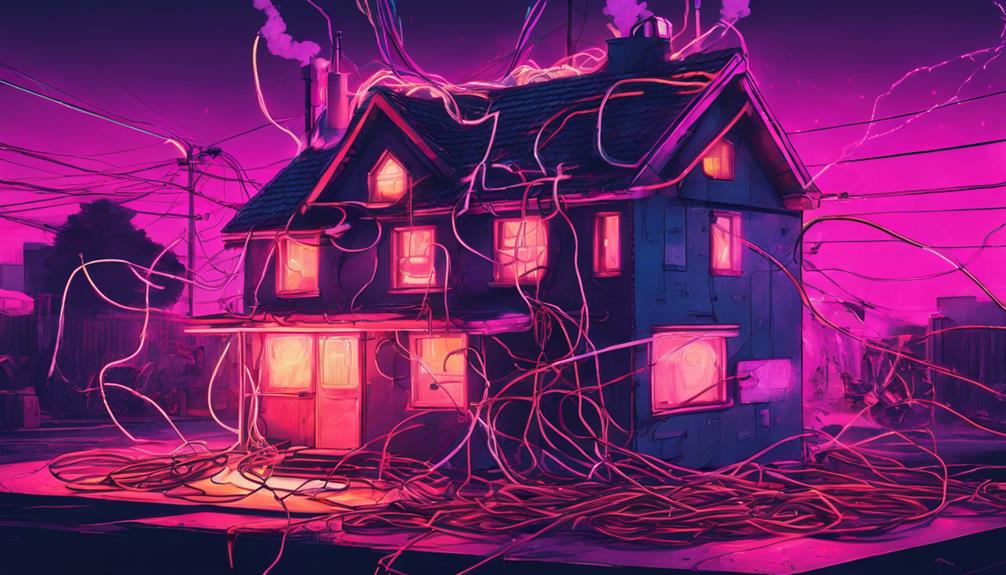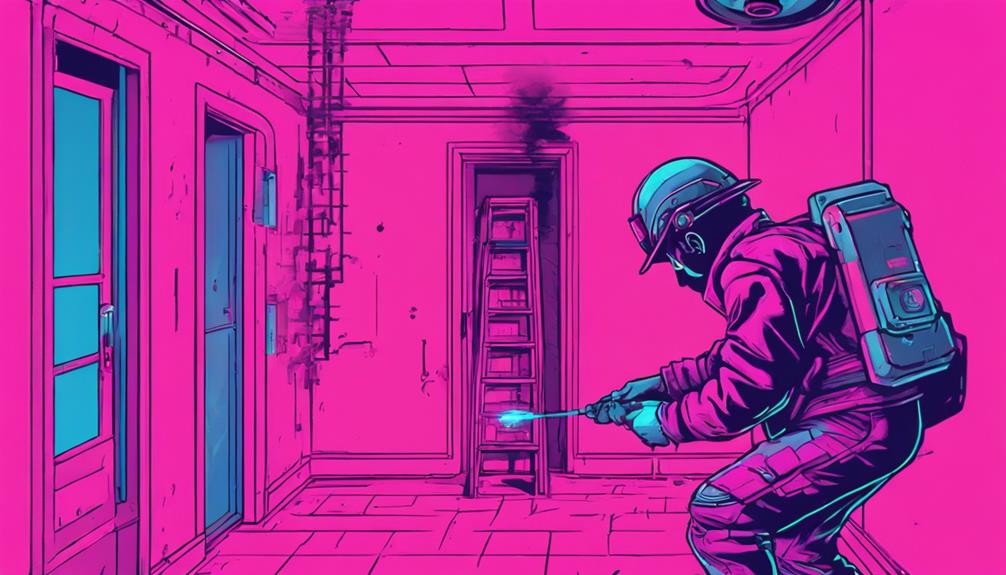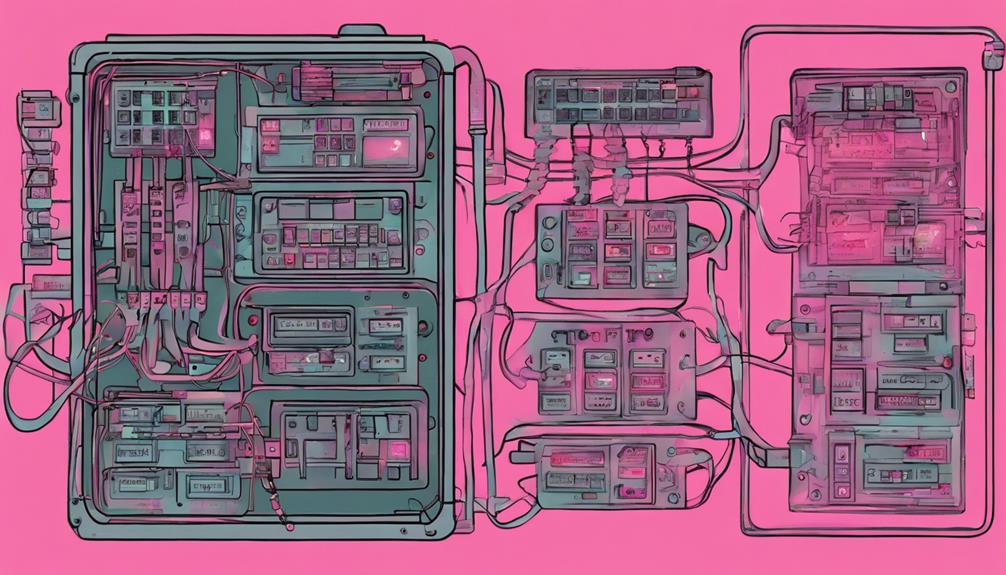In the world of home safety, navigating the realm of electrical fire prevention can feel like walking through a maze of potential hazards. But fear not, for there are practical steps you can take to safeguard your home and loved ones from the devastating effects of electrical fires.
With simple yet effective measures at your disposal, you can significantly reduce the risk of such disasters striking your home. Let's explore how a few key strategies can make all the difference in keeping your household safe and secure.
Common Causes of Electrical Fires

Common causes of electrical fires often stem from overloaded circuits and faulty wiring in homes and buildings. Understanding the dangers of faulty wiring and power strip hazards is crucial for fire prevention. Faulty wiring poses a significant risk as it can lead to short circuits, sparks, and overheating, potentially igniting a fire. It's essential to have wiring regularly inspected by a qualified electrician to ensure it's up to code and safe for everyday use.
Power strips, while convenient for powering multiple devices, can also be hazardous if not used correctly. Overloading a power strip with too many devices can exceed its wattage capacity, causing it to overheat and possibly catch fire. To prevent power strip hazards, always follow the manufacturer's guidelines on the number of devices that can be safely connected. Additionally, avoid daisy-chaining power strips together as this increases the risk of overheating and electrical fires.
Importance of Regular Inspections
Regular inspections of your electrical systems are essential to ensure safety and prevent potential hazards. By conducting regular inspections, you can identify and address issues before they escalate into dangerous situations. The frequency of these inspections is crucial; experts recommend having a professional electrician inspect your home's electrical systems at least once a year. Additionally, if you notice any warning signs such as flickering lights, frequently tripped circuit breakers, or burning smells, don't hesitate to call for an inspection promptly.
During these inspections, the electrician will check for any loose wiring, overloaded circuits, or outdated components that could pose a risk. They'll also ensure that your electrical system meets safety standards and provide maintenance tips to keep it in optimal condition. By staying proactive and addressing any potential hazards early on, you can prevent electrical fires and protect your home and loved ones.
Increasing your electrical hazard awareness is another benefit of regular inspections. You'll learn to recognize signs of trouble and take necessary safety precautions to mitigate risks. Remember, electrical fires can be devastating, but with proper maintenance and awareness, you can significantly reduce the likelihood of such incidents occurring in your home.
Proper Use of Extension Cords

When utilizing extension cords, always ensure they're rated for the intended use to prevent electrical hazards. Proper maintenance and cord organization are essential for the safe use of extension cords in your home.
Here are some tips to help you use extension cords effectively:
- Check the Cord Rating: Before using an extension cord, make sure it's rated for the intended purpose. Using a cord with a lower rating than required can lead to overheating and potential fire hazards.
- Inspect for Damage: Regularly inspect extension cords for any signs of wear and tear, such as fraying or exposed wires. Damaged cords should be replaced immediately to prevent electrical shocks or fires.
- Avoid Overloading: Don't plug too many devices into a single extension cord. Overloading can cause overheating and increase the risk of a fire.
- Unplug When Not in Use: When not in use, unplug the extension cord from the outlet. Leaving cords plugged in can be a fire hazard, especially if they're hidden under rugs or furniture.
- Organize Cords Safely: Keep extension cords away from high-traffic areas where they can be tripped over. Use cord organizers or tape to secure cords along baseboards or walls to prevent accidents.
Overloading Electrical Outlets
To prevent electrical hazards, be cautious about overloading electrical outlets to avoid potential fire risks. Proper outlet maintenance is essential for electrical safety at home. Overloading outlets by plugging in too many devices can lead to overheating and potentially cause a fire. It's crucial to only use outlets for their intended purpose and avoid daisy-chaining multiple power strips or extension cords together.
When it comes to power strip usage, make sure you're aware of the power requirements of the devices you're connecting. Avoid plugging in high-power appliances like space heaters or air conditioners into power strips, as they can easily overwhelm the outlet and pose a fire hazard. Instead, these appliances should be directly plugged into wall outlets to ensure safe operation.
Regularly inspect your outlets for any signs of wear or damage. If you notice any scorch marks, buzzing sounds, or outlets that are warm to the touch, immediately unplug all devices and refrain from using the outlet until it can be inspected by a qualified electrician. By practicing good outlet maintenance and being mindful of power strip usage, you can significantly reduce the risk of electrical fires in your home. Remember, fire prevention starts with you.
Installing Smoke Alarms

To enhance your home's safety measures further, one critical step is ensuring proper installation of smoke alarms. Smoke alarms are essential in alerting you and your family to the presence of a fire, providing valuable time to evacuate safely.
Here are some key tips for installing smoke alarms effectively:
- Placement: Install smoke alarms on every level of your home, including inside bedrooms and outside sleeping areas. Make sure they're interconnected so that if one alarm sounds, they all sound.
- Quantity: It's recommended to have smoke alarms in every bedroom, outside each sleeping area, and on every level of your home, including the basement.
- Maintenance: Test smoke alarms monthly by pressing the test button, and replace the batteries at least once a year. It's also crucial to replace the entire smoke alarm unit every ten years.
- Interconnection: For optimal safety, connect all smoke alarms so that when one detects smoke, they all sound simultaneously.
- Sensitivity: Ensure your smoke alarms are sensitive enough to detect both fast-burning and smoldering fires. Consider installing photoelectric smoke alarms for better coverage.
Proper installation and maintenance of smoke alarms are vital in protecting your home and loved ones from the dangers of a fire. By following these guidelines, you can significantly increase your home's fire safety preparedness.
Safe Handling of Appliances
For safe handling of appliances in your home, it's crucial to understand proper usage and maintenance guidelines to prevent accidents and ensure longevity. Appliance maintenance plays a significant role in keeping your devices in optimal condition and reducing the risk of electrical fires. Regularly inspect appliances for any signs of wear and tear, such as frayed cords or overheating, and promptly address any issues by either repairing or replacing the appliance.
Cord organization is another essential aspect of appliance safety. Make sure cords aren't tangled or pinched between furniture or walls, as this can cause damage to the cords and pose a fire hazard. Avoid running cords under carpets or rugs where they can overheat and potentially start a fire. Use cord organizers or ties to keep cords neat and organized, reducing the risk of accidents.
Additionally, when using appliances, avoid overloading electrical outlets or power strips. Distribute the load evenly among outlets to prevent overheating and electrical fires. Unplug appliances when not in use, especially those with heating elements like irons or toasters. This simple practice not only conserves energy but also reduces the risk of malfunctions that could lead to fires. By following these appliance maintenance and cord organization tips, you can create a safer environment in your home and minimize the chances of electrical fires.
Understanding Circuit Breakers

Understanding circuit breakers is essential for maintaining electrical safety in your home. Circuit breakers act as crucial safety devices that help protect your home from electrical fires and other hazards. Here are some key points to consider:
- Regular Maintenance: Schedule regular inspections of your circuit breakers to ensure they're in proper working condition.
- Troubleshooting: Learn how to troubleshoot basic circuit breaker issues like tripped breakers or frequent electrical surges.
- Upgrades: Consider upgrading your electrical panel if your current one is old or unable to meet the demands of modern appliances.
- Safety First: Always prioritize safety when dealing with circuit breakers. If you're unsure about anything, consult a professional electrician.
- Preventive Measures: Implement preventive measures such as not overloading circuits and using surge protectors to safeguard your electrical system.
Emergency Response Plan
In times of electrical emergencies, having a well-prepared emergency response plan is crucial to ensuring the safety of your household. To effectively respond to such situations, it is essential to have clear evacuation procedures and conduct safety drills regularly. Familiarizing all household members with the emergency response plan can prevent panic and ensure a swift and organized evacuation if needed.
| Emergency Response Plan | Details |
|---|---|
| Evacuation Procedures | Establish primary and secondary evacuation routes in case of electrical fires. Ensure everyone knows where to meet outside. |
| Safety Drills | Conduct regular safety drills to practice the evacuation procedures. Make sure all family members understand the escape plan and know how to use emergency exits. |
| Fire Extinguisher | Keep a fire extinguisher in an easily accessible location and ensure all family members are trained in its proper use. Check the extinguisher regularly to ensure it is functional. |
Having an emergency response plan is not enough; practicing it through safety drills can save lives. Knowing the location of emergency exits and having a designated meeting point outside can prevent chaos during emergencies. Additionally, ensuring that everyone knows how to operate a fire extinguisher can help contain small electrical fires before they escalate. Stay prepared, stay safe.
Frequently Asked Questions
Are There Specific Warning Signs That Indicate Potential Electrical Fire Hazards in a Home?
If you notice warning signs like flickering lights, sparking outlets, or a burning smell, it's crucial to act promptly. Early detection of these potential hazards can help prevent electrical fires in your home.
How Often Should Electrical Cords and Appliances Be Replaced to Prevent Fire Risks?
To keep your home safe, replace electrical cords and appliances every 10 years or sooner if they show signs of wear. Regularly inspect cords for damage and fraying.
Don't overload outlets, unplug appliances when not in use, and avoid using damaged cords. These simple maintenance tips and safety measures can prevent fire risks in your home.
Stay vigilant and prioritize fire prevention to ensure your family's safety.
What Are Some Common Mistakes People Make That Increase the Risk of Electrical Fires?
You mightn't realize that common misconceptions about electrical maintenance can put you at risk. Safety hazards increase when you overlook the age of home appliances.
A shocking statistic: over 50% of electrical fires are caused by faulty wiring or electrical appliances. By staying informed and proactive, you can prevent such disasters.
Are There Any Specific Safety Precautions to Take When Using Power Strips or Surge Protectors?
When using power strips, always check for damage and never overload them to prevent fires. Plug surge protectors directly into the outlet and avoid daisy-chaining them.
Be cautious with extension cords, keeping them unobstructed and never run them under rugs. Avoid outlet overload by distributing devices across multiple outlets.
Remember to unplug devices when not in use and replace damaged cords promptly. Following these power strip safety and surge protector tips can reduce fire risks.
What Should Homeowners Do if They Suspect a Potential Electrical Fire in Their Home?
If you suspect a potential electrical fire in your home, it's crucial to act quickly. Remember these emergency procedures:
- First, ensure your smoke detector is working.
- If safe, try to extinguish the fire using a fire extinguisher.
- If the fire grows, evacuate following your evacuation plan.
- Contact emergency services immediately.
Safety is key in such situations, so always prioritize your well-being and that of your loved ones.



